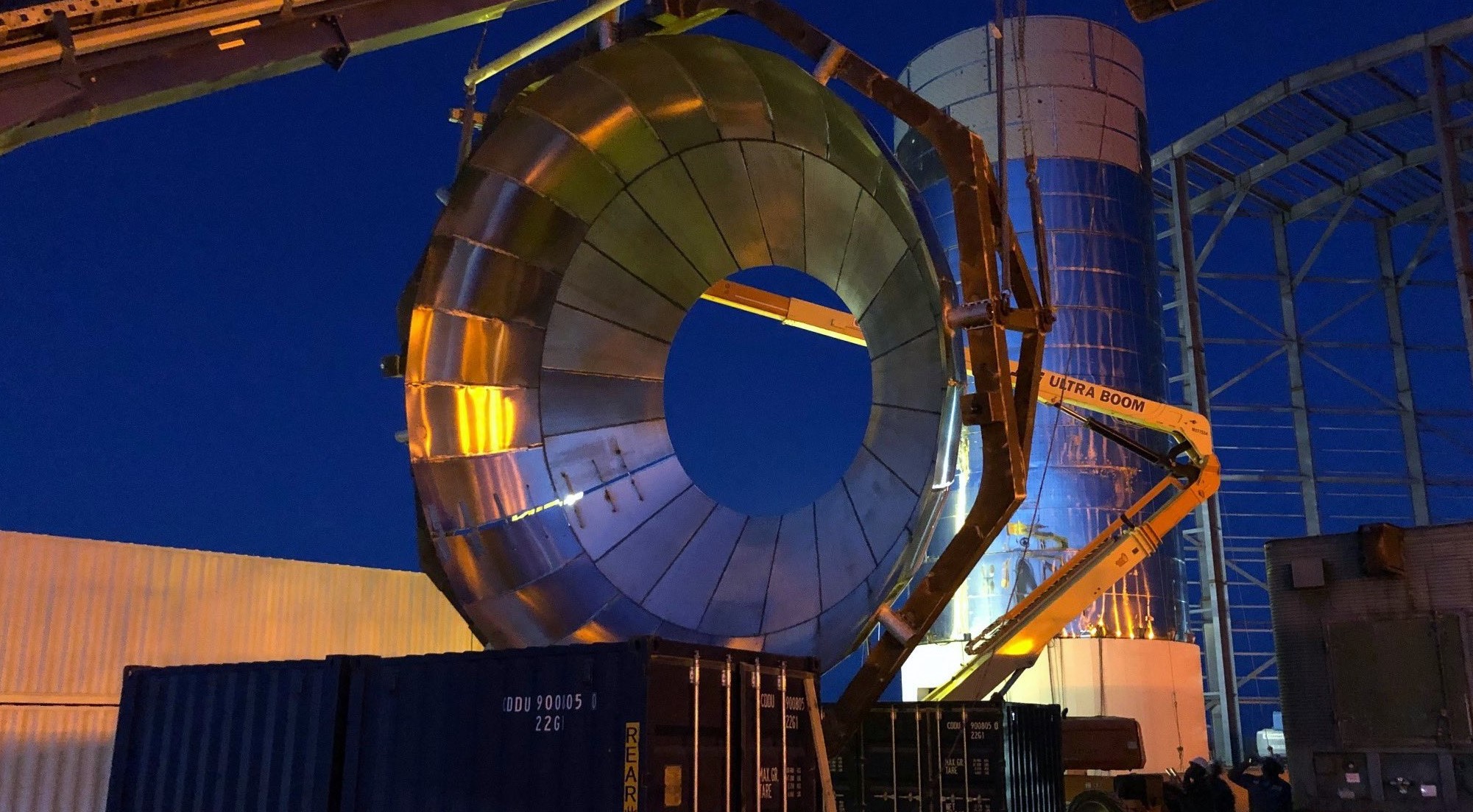
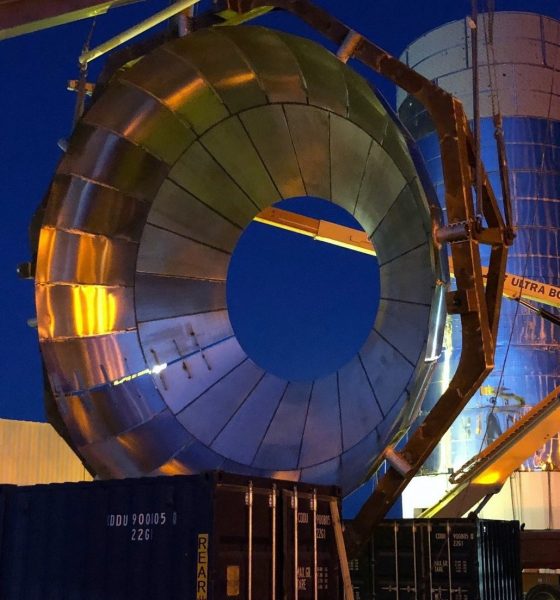
News
SpaceX preps Texas Starship’s second tank dome for installation in latest milestone
During an August 4th visit to SpaceX’s Boca Chica Starship build site, CEO Elon Musk captured and shared photos showing technicians carefully flipping the second of three propellant tank domes destined for installation inside the company’s South Texas orbital Starship prototype.
This is the latest visible step towards the completion of one of SpaceX’s two “Mk 1” Starships, said by Elon Musk to be the first orbit-capable prototypes. Per recent tweets, either or both of the prototypes – being built concurrently at separate sites in Florida and Texas – could be ready for their first flight tests as early as September or October 2019.
Set to be powered by up to three sea-level (SL) Raptors and three vacuum-optimized Raptors (RVacs), Musk has stated that SpaceX’s first two orbital Starship prototypes will likely begin flight testing with just the three SL engines installed. Recently, the SpaceX CEO did, however, indicate that development of Raptor’s vacuum variant – postponed as of a September 2018 update – had been reprioritized and said that it could actually be ready sooner than later.
Raptor Vacuum will have a significantly larger nozzle compared to the sea level engine it will be based on. According to Musk, RaptorVac will have a nozzle diameter of roughly 2.8m (9.2 ft), while the SL Raptor features a ~1.3m (4.2 ft)-diameter nozzle. With a larger diameter nozzle, a chemical rocket engine can technically generate more thrust and is significantly more efficient due to an increased expansion ratio, meaning the difference in the diameter of the nozzle exit and combustion chamber throat.
In the very simplest sense, this efficiency and thrust increase comes from the fact that a longer nozzle allows the exiting gas (reaction mass) to reach a higher velocity, thus conveying more momentum onto the rocket it is propelling.
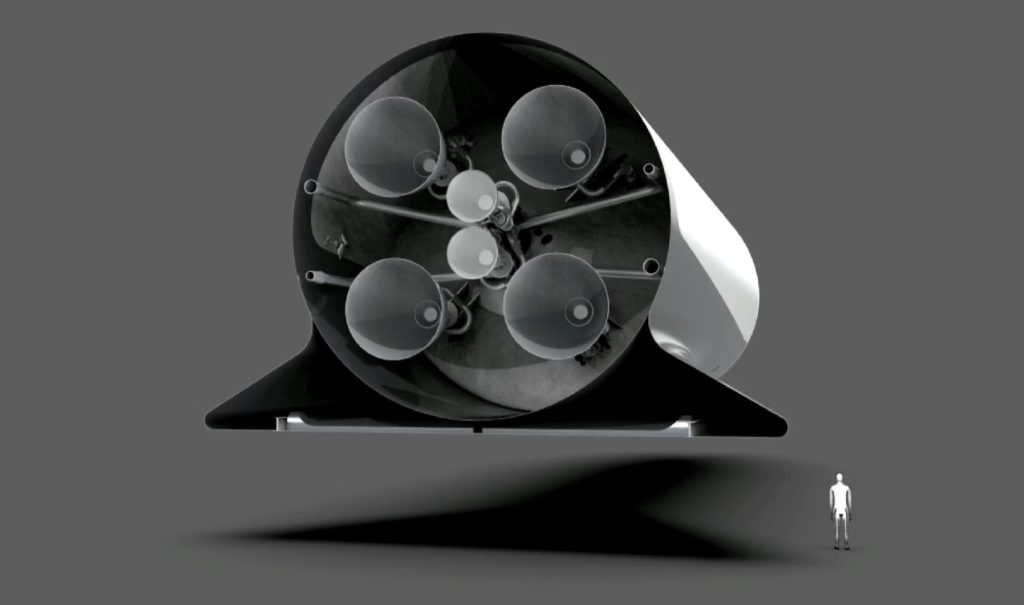
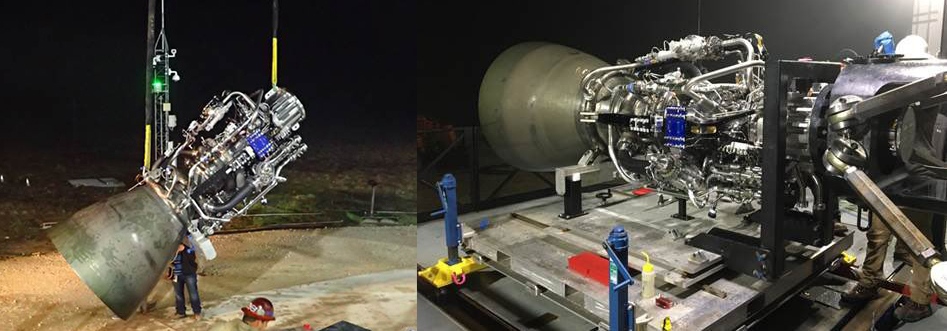
Starship’s Raptor engines, of course, use liquid methane as fuel and liquid oxygen as their oxidizer. According to SpaceX, fully fueling a combined Super Heavy and Starship stack will require an incredible ~5000 tons (11 million pounds) of propellant – ~1500 tons for Starship and ~3500 tons for Super Heavy.
To contain such a huge amount of fuel and oxidizer, Starship (and Super Heavy) must effectively be turned into extremely mass-efficient pressure vessels, capable of supporting something like 20 kilograms of propellant with every kilogram of rocket structure.
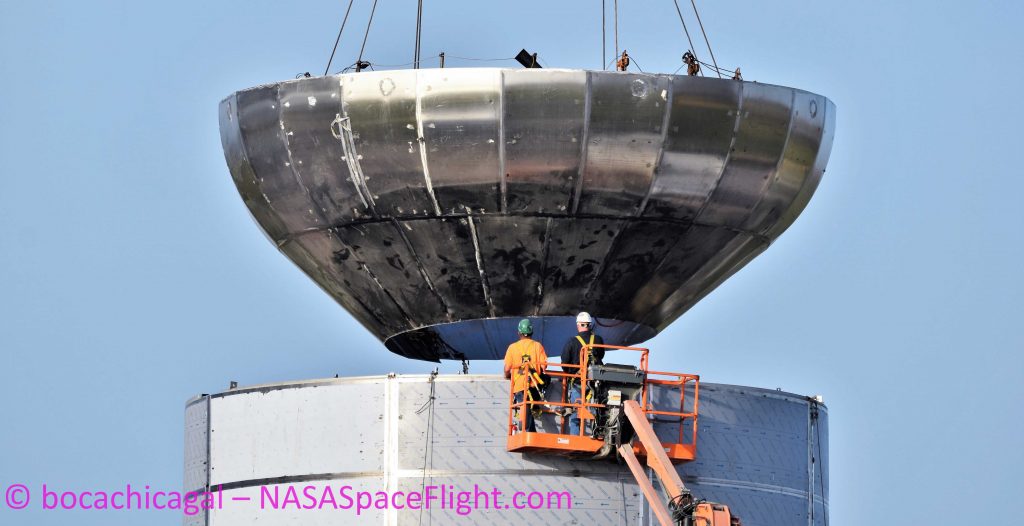
SpaceX’s installation of bulkheads in the Texas Starship prototype are thus an inherent indication that the rocket is being readied to play the role of a massive, ultra-strong pressure vessel. While sitting vertically, a fueled Starship’s tank domes will be subjected to immense pressures and forces from the sheer weight of the liquid oxygen and methane held above them.
Additionally, the rearmost dome will likely be partially or fully integrated into Starship’s thrust structure, meaning that it will simultaneously be subjected to the thrust of 3-6 Raptors (as much as 600-1200 tons of thrust) and the gravity of 300 metric tons of methane. It’s unclear if SpaceX is planning to reinforce Starship and Super Heavy tank bulkheads with structural add-ons, but it’s safe to assume that some level of reinforcement will be required.
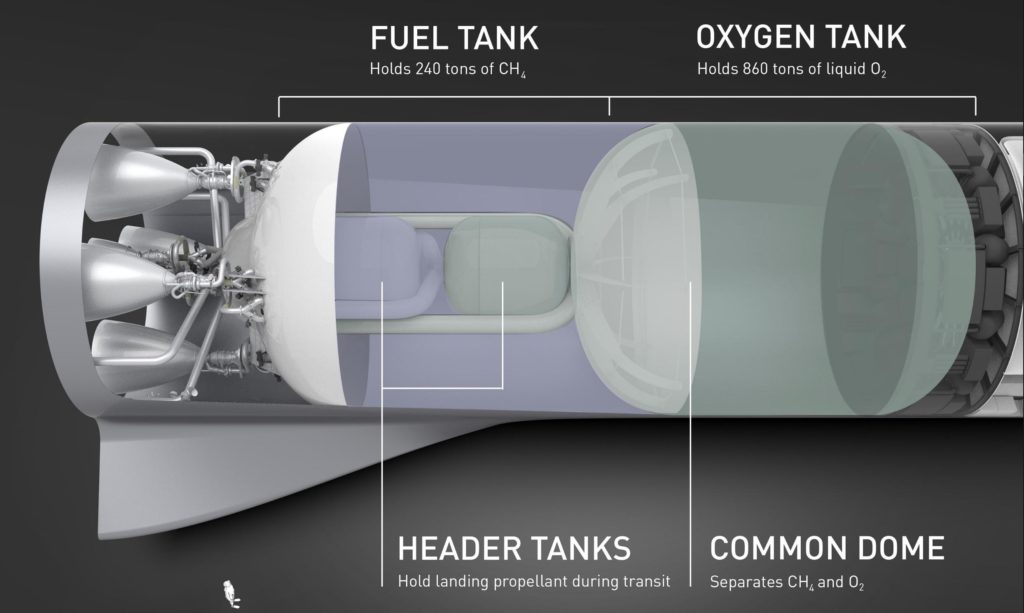
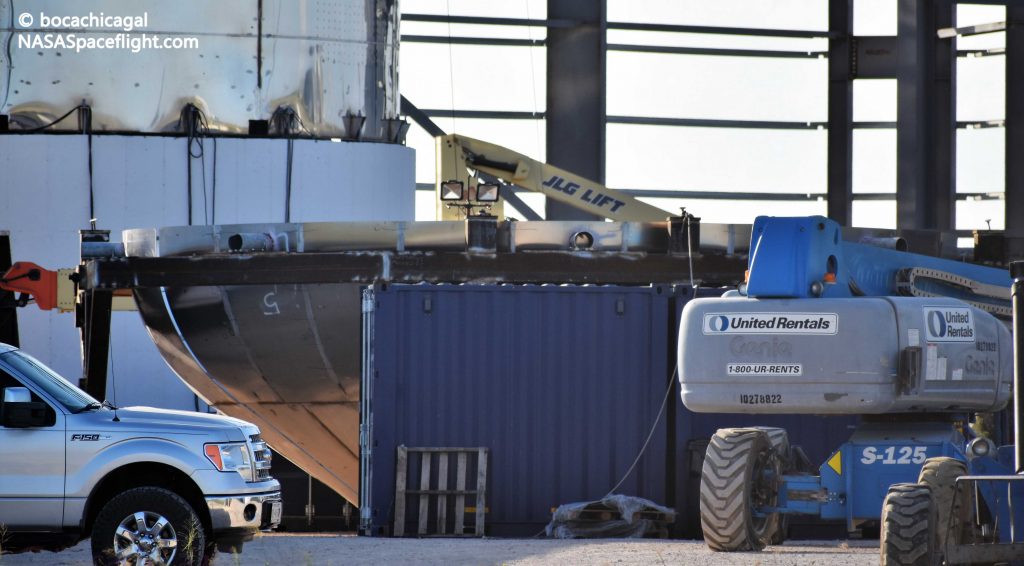
SpaceX CEO Elon Musk’s planned August 24th presentation on Starship and Super Heavy will likely (hopefully) provide some new details on the structure and general design of the company’s advanced, next-generation rocket.
Check out Teslarati’s Marketplace! We offer Tesla accessories, including for the Tesla Cybertruck and Tesla Model 3.

News
Elon Musk’s Grokipedia surges to 5.6M articles, almost 79% of English Wikipedia
The explosive growth marks a major milestone for the AI-powered online encyclopedia, which was launched by Elon Musk’s xAI just months ago.

Elon Musk’s Grokipedia has grown to an impressive 5,615,201 articles as of today, closing in on 79% of the English Wikipedia’s current total of 7,119,376 articles.
The explosive growth marks a major milestone for the AI-powered online encyclopedia, which was launched by Elon Musk’s xAI just months ago. Needless to say, it would only be a matter of time before Grokipedia exceeds English Wikipedia in sheer volume.
Grokipedia’s rapid growth
xAI’s vision for Grokipedia emphasizes neutrality, while Grok’s reasoning capabilities allow for fast drafting and fact-checking. When Elon Musk announced the initiative in late September 2025, he noted that Grokipedia would be an improvement to Wikipedia because it would be designed to avoid bias.
At the time, Musk noted that Grokipedia “is a necessary step towards the xAI goal of understanding the Universe.”
Grokipedia was launched in late October, and while xAI was careful to list it only as Version 0.1 at the time, the online encyclopedia immediately earned praise. Wikipedia co-founder Larry Sanger highlighted the project’s innovative approach, noting how it leverages AI to fill knowledge gaps and enable rapid updates. Netizens also observed how Grokipedia tends to present articles in a more objective manner compared to Wikipedia, which is edited by humans.
Elon Musk’s ambitious plans
With 5,615,201 total articles, Grokipedia has now grown to almost 79% of English Wikipedia’s article base. This is incredibly quick, though Grokipedia remains text-only for now. xAI, for its part, has now updated the online encyclopedia’s iteration to v0.2.
Elon Musk has shared bold ideas for Grokipedia, including sending a record of the entire knowledge base to space as part of xAI’s mission to preserve and expand human understanding. At some point, Musk stated that Grokipedia will be renamed to Encyclopedia Galactica, and it will be sent to the cosmos.
“When Grokipedia is good enough (long way to go), we will change the name to Encyclopedia Galactica. It will be an open source distillation of all knowledge, including audio, images and video. Join xAI to help build the sci-fi version of the Library of Alexandria!” Musk wrote, adding in a later post that “Copies will be etched in stone and sent to the Moon, Mars and beyond. This time, it will not be lost.”
News
Tesla Model 3 becomes Netherlands’ best-selling used EV in 2025
More than one in ten second-hand electric cars sold in the country last year was a Tesla Model 3.

The Tesla Model 3 became the most popular used electric car in the Netherlands in 2025, cementing its dominance well beyond the country’s new-car market.
After years at the top of Dutch EV sales charts, the Model 3 now leads the country’s second-hand EV market by a wide margin, as record used-car purchases pushed electric vehicles further into the mainstream.
Model 3 takes a commanding lead
The Netherlands recorded more than 2.1 million used car sales last year, the highest level on record. Of those, roughly 4.8%, or about 102,000 vehicles, were electric. Within that growing segment, the Tesla Model 3 stood far ahead of its competitors.
In 2025 alone, 11,338 used Model 3s changed hands, giving the car an 11.1% share of the country’s entire used EV market. That means more than one in ten second-hand electric cars sold in the country last year was a Tesla Model 3, Auto Week Netherlands reported. The scale of its lead is striking: the gap between the Model 3 and the second-place finisher, the Volkswagen ID3, is more than 6,700 vehicles.
Rivals trail as residual values shape rankings
The Volkswagen ID.3 ranked a distant second, with 4,595 used units sold and a 4.5% market share. Close behind was the Audi e-tron, which placed third with 4,236 registrations. As noted by Auto Week Netherlands, relatively low residual values likely boosted the e-tron’s appeal in the used market, despite its higher original price.
Other strong performers included the Kia Niro, the Tesla Model Y, and the Hyundai Kona, highlighting continued demand for compact and midsize electric vehicles with proven range and reliability. No other model, however, came close to matching the Model 3’s scale or market presence.
News
Tesla Model Y Standard Long Range RWD launches in Europe
The update was announced by Tesla Europe & Middle East in a post on its official social media account on X.

Tesla has expanded the Model Y lineup in Europe with the introduction of the Standard Long Range RWD variant, which offers an impressive 657 km of WLTP range.
The update was announced by Tesla Europe & Middle East in a post on its official social media account on X.
Model Y Standard Long Range RWD Details
Tesla Europe & Middle East highlighted some of the Model Y Standard Long Range RWD’s most notable specs, from its 657 km of WLTP range to its 2,118 liters of cargo volume. More importantly, Tesla also noted that the newly released variant only consumes 12.7 kWh per 100 km, making it the most efficient Model Y to date.
The Model Y Standard provides a lower entry point for consumers who wish to enter the Tesla ecosystem at the lowest possible price. While the Model 3 Standard is still more affordable, some consumers might prefer the Model Y Standard due to its larger size and crossover form factor. The fact that the Model Y Standard is equipped with Tesla’s AI4 computer also makes it ready for FSD’s eventual rollout to the region.
Top Gear’s Model Y Standard review
Top Gear‘s recent review of the Tesla Model Y Standard highlighted some of the vehicle’s most notable features, such as its impressive real-world range, stellar infotainment system, and spacious interior. As per the publication, the Model Y Standard still retains a lot of what makes Tesla’s vehicles well-rounded, even if it’s been equipped with a simplified interior.
Top Gear compared the Model Y Standard to its rivals in the same segment. “The introduction of the Standard trim brings the Model Y in line with the entry price of most of its closest competition. In fact, it’s actually cheaper than a Peugeot e-3008 and costs £5k less than an entry-level Audi Q4 e-tron. It also makes the Ford Mustang Mach-E look a little short with its higher entry price and worse range,” the publication wrote.








